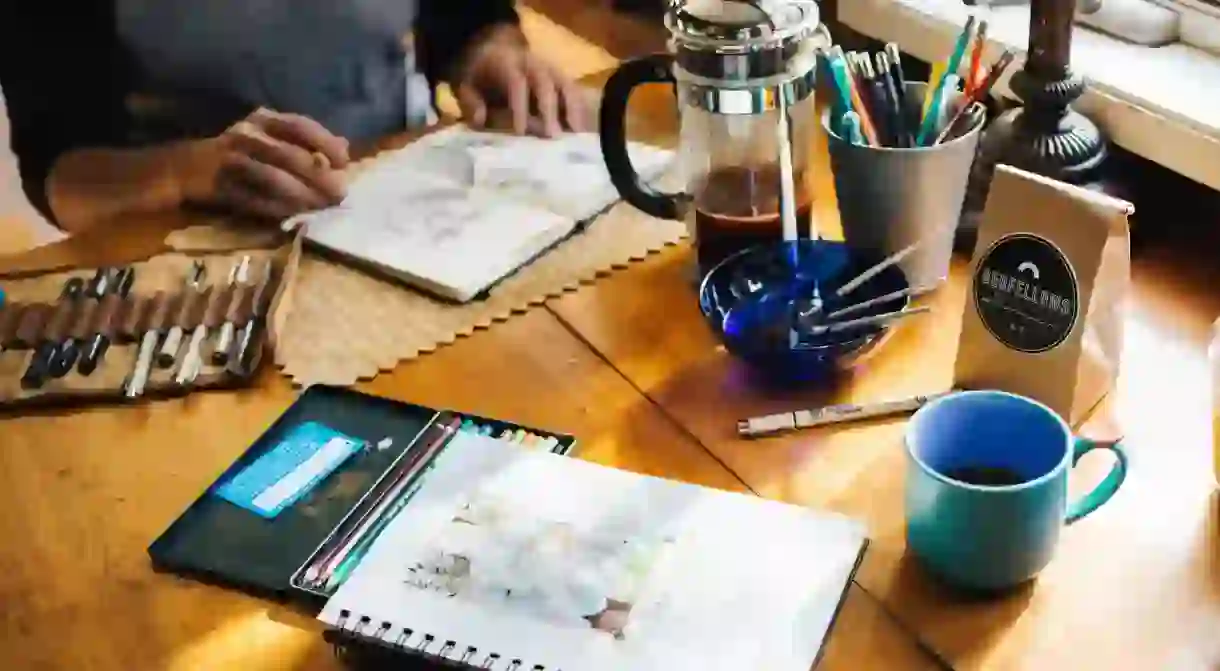Moroccan Contemporary Artists You Need to Know

In a corner of Africa, a country often overlooked, art is blossoming. These contemporary Moroccan artists explore boundaries of colour, form and ethics in their art. Here are 10 of the best.
Did you know – Culture Trip now does bookable, small-group trips? Pick from authentic, immersive Epic Trips, compact and action-packed Mini Trips and sparkling, expansive Sailing Trips.
Noureddine Daifallah
Moroccan calligrapher, Noureddine Daifallah, fuses contemporary art with traditional Arabic calligraphy creating an electrifying blend of old and new in his work. His works are mysteriously untitled allowing the imagination free range amongst the lines and colours of his paintings. The delicate patterns of blood red and the smudges of burnt gold amongst the confident bold lines of lettering create a surface of unfathomable depth, like a trickle of water glittering at the bottom of a deadly ravine. The complexity of Noureddine Daifallah’s work creates a visual poetry: beautiful, enchanting and eloquent.
Bouchta El Hayani
Trained in France, Bouchta El Hayani, is a rare breed of Moroccan artist with a true mastery of traditional drawing techniques. Works such as Corps Humain demonstrate the proficiency with which El Hayani can portray the human form, however it is works such as L’Ange that are so beautifully comparable to this. The stylised white trapezoid figure of an angel hovers between humanity and the divine. Two great feathered wings float beside the quivering white body denoting the subject. A simple crescent sliver of light is a crowning halo. It is El Hayani’s knowledge of anatomy and the important aspects of a subject that allow him to effectively portray a figure betwixt the realms of earth and heaven.
Malika Agueznay
Painter, sculptor and engraver, Malika Agueznay is certainly an acocomplished visual artist. Her works are almost a form of OpArt with the colours of Morocco. Hand in Hand is an abstract work or calm blue and turbulent orange. The frondescent forms interlock and harmonise between the colours. Amongst the vibrant orange are figures remininiscent of Fauvist dances. Algue, meaning seaweed, takes on the twisting forms of the plant, but it is the juxtaposition of colours that makes this work pulsate with life. The geometric allocation of colour and form evokes a visual strangeness in her art as well as a nod to her Moroccan heritage.
André Elbaz

Son of storyteller and one of Morocco’s first photogaphers, André Elbaz certainly inherited his fathers legacy. His urns containing sliced paintings are inspired by the horrors of 9/11 and the collapse of the Twin Towers in New York. They are enigmatic and beautiful, but also dark with connotations of funeral urns. Standing in front of the urns, you do not feel overwhelmed by their darkness, they do not speak of death, the terror is a memory, but they never fail to stir emotion – shards of paper entrapped in cool, hard glass.
Mounir Fatmi

The ‘visual spaces’ of Mounir Fatmi deal with eroded ideologies and the desecration of religion. The end of all things is embodied in defunct technology and dead languages, exploring our ‘doubts, fears and desires’. In the Absence of Evidence to the Contrary is a vast spire of fluorescent light bulbs soaring upwards from the floor. Warm light can be comforting, but there is something unsettling about the cold, not warm, glow of life in this installation. It is dynamic and the fluorescent lights produce static electricity literally creating an electrifying atmosphere which enhances the feeling of unease when stood before these works.
Tibari Kantour
The flaming landscapes of Tibari Kantour are like paper Rothkos, elegantly simple, yet with consuming complexity. The works of The Tree are a patchwork of scarlet reds, burnt ochres and delicate honey yellows. Amidst the white paper skies are ghosts of trees shivering in the distance, delicately textured like watermarks. In some, fine lines of black or orange dance across the page as light as the toes of a ballerina tracing unknown forms in the earth of the painting. Tibari Kantour successfully balances art between fantasy and reality, abstracted, but still imaginable.
Abdellatif Ilkem
Born in Izakarn, Southern Morocco, visual artist, Abdellatif Ilkem creates a variety of controversial and unexpected artworks. The Crossed Arms series displays a variety of animals – pigs, donkeys, gorillas – standing upon their hind legs with arms crossed. Are the animals waiting for instruction? Are they authoritative observers? It is hard to tell, but the unsettling humanness of the animals is a worrying commentary of people and life today. The artifice mocks the institutions of society, what makes humans different from other beasts? The questioning nature of Abdellatif Ilkem’s work is a welcome detour from day to day life.
Safaa Erruas
Using paper, needles, delicate chains and fine threads, Safaa Erruas has gained a worldwide reputation by means of the textural emotion in her art. On My Skin involves thorns that have been pushed through cotton paper. The multitude of paper piercings resemble skin, pores and scars by their permanence. The harsh brown thorns protrude from the soft cotton surface evoking pain of the present and pain of the past through the skin-like surfaces. Safaa Erruas’s work is threateningly emotive and reverberates within everyone.
Zakaria Ramhani
Artist, Zakaria Ramhani, takes a very different approach to arabic calligraphy as an artistic gesture. In a style not dissimilar to Pop Art, the works of Zakaria Ramhani are often politically motivated and therefore controversial. You Were My Only Love was censored at Art Dubai for portraying police brutality in Cairo’s Tahrir Square. Ramhani then altered the painting, replacing police with gorillas, mocking the establishment and becoming a symbol of the Egyptian protest against military power. The incorporation of arabic writing into this work is a point of contention, but locates the work within the realms of the Middle East and North Africa, maintaining links with the events in Cairo.













